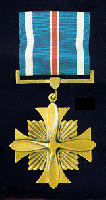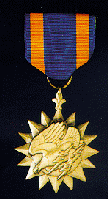|
|
|
[Search
Tip: Use " " for better search results ex. "John Q. Doe";
"City of ..."]
|
|
S/Sgt
David H. Fisher
Radio Operator
|
I
attended high school at Jennings, LA, and graduated
in May 1943 at seventeen, with my eighteenth birthday
coming up in December of that year. During my senior
year, I took the Navy V-12 test, with hopes of getting
a few semesters of college in, and then going to officer's
training school. I passed the mental test, but was rejected
on the physical because, of all things, I had an overbite!
Not
being old enough to enlist at the time, but expecting
to do so, I worked as a roughneck in the oil field for
six months. On November 11, 1943, I enlisted in the
Army Aviation Cadet Program, was eighteen on December
12, received orders on December 16, to report for active
duty at Camp Beauregard, LA on December 23. The entire
contingent of 45-50 young men like myself from southwest
Louisiana were sent to Gulfport Field, Mississippi,
for basic training. While there we spent a week at Keesler
Field in Biloxi, MS, where we took batteries of classification
tests. None of us made the cadet program, and I ended
up going to radio school at Scott Field, Illinois in
their 22-week radio-operator-mechanics course. Upon
completion of that course, I went to a special B-29
radio school at Scott Field, after which I was given
a 14-day delay enroute to Lincoln, Nebraska. It was
at this base, probably in October or November that our
crew was assembled. From there by train, we went to
Clovis Army Air Base, Clovis, New Mexico, where we did
our flight training as a replacement crew. After this
training, we went to Kearney, Nebraska, which was our
overseas staging area. We were issued flight clothes
and other essentials, and very importantly to us - a
brand new B-29. From there, we flew to Mather Field,
California, near Sacramento, from which base we were
to fly overseas. We took off from there in early April,
but developed engine problems very early in the flight,
and returned to Mather.
Having
to wait on parts, it took over a week to remedy the
problem. Without very much to do, our entire crew, officers
and enlisted men alike, hung out together - going into
Sacramento every night, eating and visiting together,
etc. In retrospect, I have thought how important this
time was in helping to mold our crew psychologically.
We
finally did leave for Oahu, Hawaii, and landed at John
Rodgers Field on April 13, 1945, which was the day of/after
President Roosevelt's death. We did go into Honolulu,
but most everything was closed because of the president's
death. The next day we took off for Kwajalein, but again,
it was determined that a cowling flap did not open wide
enough to cool one of the engines adequately, so we
landed at Johnston Island, about 400 - 600 miles southwest
of Hawaii - a very small island perhaps 2 miles long
- not really meant to accommodate a B-29. After a brief
stop, we proceeded to Kwajalein, where we stayed overnight,
while they serviced our plane and armed all the gun
turrets. From there, we flew to Saipan, where, even
before all the engines were shut down, we were informed
to remove all our personal belongings from the plane,
because it was to be given to another crew.
We
were on Saipan in a transient barracks for 10-12 days
before being assigned as the replacement crew we were,
to the 39th Bomb Group, 62nd Bomb Squadron, stationed
at North Field, Guam as Crew No. 55. We flew several
practice missions before being scheduled for our first
combat mission on May 7 over Otake, Honshu. Actually
a cracked cylinder on an engine caused us to abort and
land at Iwo Jima. Our first completed mission was over
Nagoya, Honshu on May 14. By the end of the war, we
had flown 22 missions.
Having
accumulated the minimum number of 50 points in the discharge
system that was being used to separate men from the
service, I was discharged at Fort Sam Houston, San Antonio,
TX, on November 22, 1945.
I
started college at Southwestern Louisiana Institute
(S.L.I.) in Lafayette, LA in March 1946. While there,
I played football and ran track for four years. High
points, I suppose, of that athletic competition, was
running the 400 meter hurdles in preliminary Olympic
trials in the N.C.A.A. championships at the University
of Minnesota in 1948; being drafted in a middle round
by the Baltimore Colts; and having been placed in the
athletic hall of fame at my college. I had accepted
an assistant coach position at my old high school, and
had set our wedding date prior to the draft - so I went
with the coaching and teaching position. I coached first
as an assistant, and then as head coach, for eight years,
during which time I got my master's degree from L.S.U.
I joined the faculty of the college I graduated from,
which was then called the University of Southwestern
Louisiana (U.S.L.) in the physical education department.
During that time, I went to L.S.U. and got my Ph. D.
in 1970. I retired from the university early in 1974,
and spent six years as a partner in a cathodic protection
(corrosion) business.
In
1980, after having sold the corrosion business, I began
assisting my wife with running two preschools and early
childhood development centers - which was an area in
which I had done my dissertation for the Ph. D. We are
still involved in this, with three of our children now
involved, and beginning to take over completely.
Shirley,
my wife, and I were married August 5, 1950, and had
seven children - five-girls, and two boys - present
ages 37 - 50. We now have 18 grandchildren and 2 great-
grandchildren. Most all of these offspring are in Lafayette
or a few hours driving distance from our home.
Until
very recently when I received a phone call from Pete
Weiler, son of Robert
Weiler, who was in the 39th Bomb Group, 61st Bomb
Squadron, I had heard nothing of gatherings of 20th
Air Force members. While in Minnesota in 1948, I visited
with Richard Jacobsen, our flight engineer, who lived
south of Minneapolis, and the two of us drove down to
Iowa to visit Roland Johnson, our right waist gunner.
Two years ago, I made telephone contact with our radar
navigator, Dan Clendening, who lives in Gainesville,
GA, and we have corresponded on occasion. Through tips
from Pete, I have recently talked on the phone with
our left waist gunner, Don
Hartshorn in Columbus, Ohio, and our tail gunner,
David Hirsch, in Senoia, GA. It has been learned that
members of our crew who are deceased are: Robert Dudley,
aircraft commander, Harvard Cox, co-pilot, George Tucker,
bombardier, and Richard Jacobsen, flight engineer. As
this is being written, no contact has been made with
Francis Smith, navigator, or J.C. Donoghue, central
fire control gunner.
Only
through contacts such as have now been made, can one
begin to recollect memories and experiences that you
would like to hold onto. It is for this reason that
I would hope the surviving members of our crew could
one day get together, and that I might be able to attend
future gatherings of the 39th Bomb Group.
|
View
David Fisher's WWII mission dairy by clicking here
|
|
S/Sgt David H. Fisher took his final flight on 27 September 2021
|
Crew
55 Main Page
62nd
Squadron Crew Index
|
|









